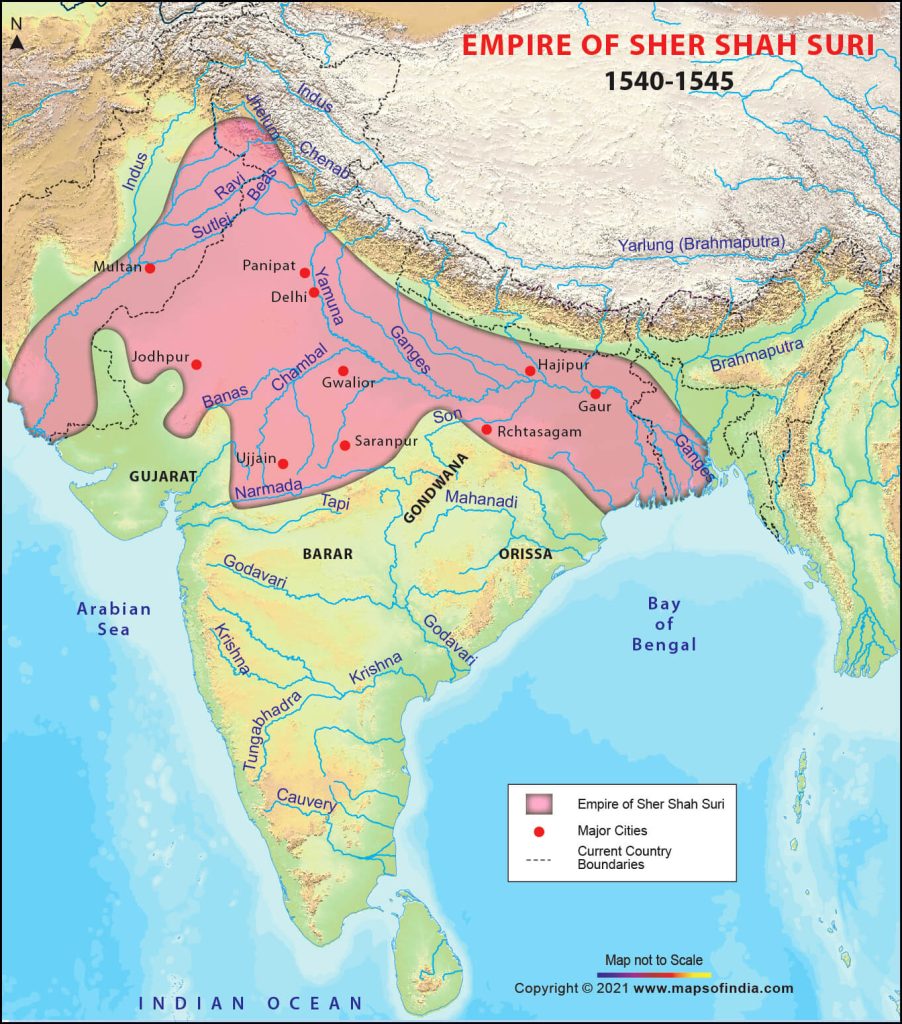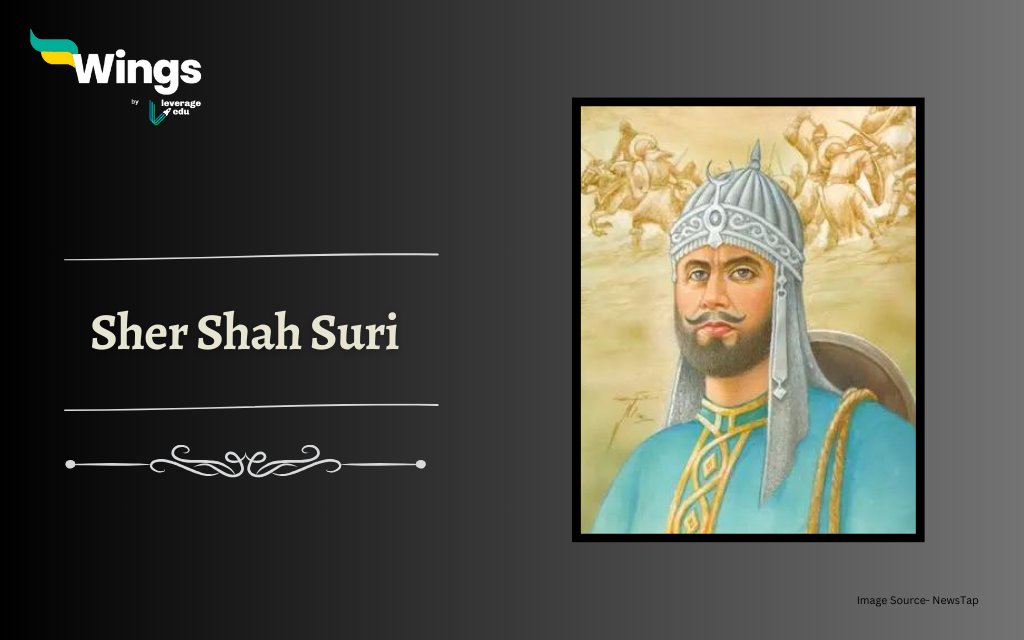Sher Shah Suri, also known as Sher Shah of Sur and called the “Just King”, was one of the most renowned rulers in the medieval history of India. Born as Farid Khan, he ascended the throne in 1540 and ruled until his death in 1545. He was known for his vision and progressive policies. Sher Shah Suri made significant contributions in various aspects of governance and infrastructure development. In this article, we will delve into the life, history, policies, administration, and rule of Sher Shah Suri, highlighting his remarkable achievements and lasting impact on Indian history.
Contents
About the Early Life of Sher Shah Suri
Sher Shah Suri’s formative years laid the foundation for his exceptional leadership. Born into a jagirdar family under the Lodi dynasty, young Farid faced family conflicts that honed his resilience and strategic acumen.
- Childhood and Education: Farid grew up in Sasaram, managing his father’s estates despite tensions with his stepmother. He studied Arabic and Persian in Jaunpur, gaining insights into administration and governance.
- Entry into Service: At 15, he joined the service of Bihar’s ruler, Bahar Khan Lohani, earning the title “Sher Khan” for reportedly killing a tiger single-handedly. This bravery propelled him through military ranks.
- Consolidation in Bihar and Bengal: By 1530, Sher Khan became Bihar’s de facto ruler. In 1538, he overran the Bengal Sultanate, establishing Afghan dominance in the east.
His ascent reflected a blend of military prowess and administrative skill, setting the stage for challenging the Mughals.

Also Read – Sayyid Dynasty: UPSC Notes, History, Architecture, Economy
What is the Historical Significance of Sher Shah Suri’s Reign?
He was the founder of the Sur Dynasty and established the second Afghan Empire, which was established after the Lodhi Dynasty.
- Rise to Power: Sher Shah initially served under various rulers, including the Mughals, until he formed his own independent kingdom by defeating Humayun, the Mughal emperor, in the Battle of Chausa in 1539.
- Defeat of Humayun: Once again, in 1540, Sher Shah Suri defeated the Mughal emperor Humayun in the Battle of Kannauj, which led to his own ascension to the throne.
- Construction of Royal Road: One of his remarkable achievements was the construction of the Grand Trunk Road, also known as “Sadak-e-Azam.” Stretching over 1,600 miles, this road connected the major cities, facilitating trade and communication throughout the empire.
- Introduction of Coin: He introduced the new silver coin named “ Dam”. And they were in circulation till 1835. It is believed that
- Justice System: The emperor’s rule was known for its impartial and efficient justice system. He established a network of courts and introduced the concept of Qazis (judges) to ensure fair trials and efficient dispensation of justice.
Policies of Sher Shah Suri
During Sher Shah Suri’s rule, he introduced many policies for his dynasty to excel. Some of them are –
- Land Reforms: Sher Shah implemented several land reforms to alleviate the plight of farmers. He introduced the system of measurement of land known as “Gaz-i-Sher Shahi,” which helped in accurate taxation and assessment. Also, the land was measured as Sikandari Gaz (32 points).
- Revenue and Taxation: He abolished the oppressive taxes and introduced a new system called “zabti-i-har-sal,” which involved regular assessment and collection of revenue. This ensured a fair and transparent taxation process.
- Irrigation Projects: To boost agriculture, Sher Shah initiated several irrigation projects, including the construction of dams, canals, and reservoirs. This led to increased agricultural productivity and improved the lives of farmers.
- Postal System: Recognizing the importance of communication, Sher Shah introduced an efficient postal system known as “Darogha-i-Dak Chauki.” This facilitated the exchange of information and enhanced the administration’s efficiency.
- Infantry Reform: He maintained his personal royal force and called it Khasa Kail. He was also inspired by Allauddin Khilji and branded his horse following in his footsteps.
Administration under Sher Shah Suri
He continued the central administration, which was followed in the Sultanate Period.
- To aid him, he was accompanied by 4 important officials, namely –
- Diwan -i- Wizarat/Wazir – Revenue and Finance.
- Diwan-i-Ariz – Army Incharge
- Diwan- i -Insha – Minister of Communication
- Diwan-i- Rasalat – Foreig Minister
- Barid – Intelligence.
- His kingdom was organised into administrative units known as “Sarkars,” and it consisted of a total of forty-seven such divisions.
- Each Sarkar was again divided into various Parganas.
- For each Parganas, various in-charges were placed like-
- Amin – Land Revenue
- Shiqdar – Military Officer
- Karkuns- Accountants
- Fotedar – Treasurer
- Chief Shiqdar – Law and Order and
- Chief Munsif – Judge
- Mauza – Village was the lowest level in terms of administration.
- The administrative Units were called Iqtas
- He introduced Patta, the amount that each farmer has to pay.
- He also introduced Qabuliyat, which was the deed of agreement.
Also Read – Saint Ramanujacharya: Life, Philosophy, Works
Sher Shah Suri’s reign occupied the whole of North India except Nepal, Assam, Gujarat, and Kashmir. Although his reign was cut short due to his untimely demise in 1545, he ruled for only 5 years, but his successors ruled for 15 years. He was succeeded by Emperor Akbar, when the Sur’s Wazir, Hemu, was defeated in the Second Battle of Panipat in 1556.
FAQs
Sher Shah Suri (born Farid Khan) was the founder of the Sur Empire (1540–1555). He earned the title “Sher” (meaning lion) after single-handedly killing a tiger in his youth, and the nickname stuck because of his fearless leadership and battlefield bravery.
He ruled for only 5 years, from 1540 to 1545. Despite the short reign, his administrative and infrastructural reforms had a lasting impact.
He established an extremely fair and efficient justice system, punished corrupt officials severely, heard public grievances personally, and ensured equal treatment for Hindus and Muslims.
The Grand Trunk Road (GT Road) is one of the oldest and longest highways in Asia. Sher Shah Suri revived and extended the ancient Uttarapatha route, stretching ≈2,500 km from Sonargaon (Bangladesh) to Peshawar (Pakistan), planting trees and building 1,700 sarais along the way.
Relevant Blogs
We hope you liked our blog. If you want to read more articles like this, you can visit our general knowledge page on Indian History!
 One app for all your study abroad needs
One app for all your study abroad needs














